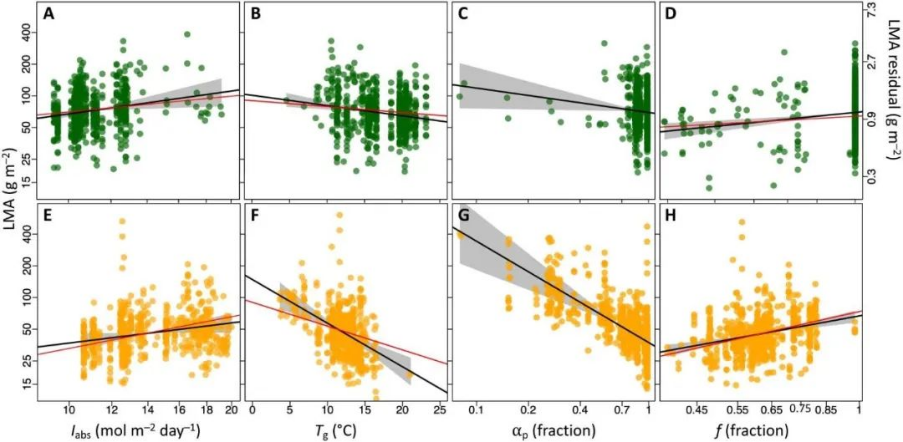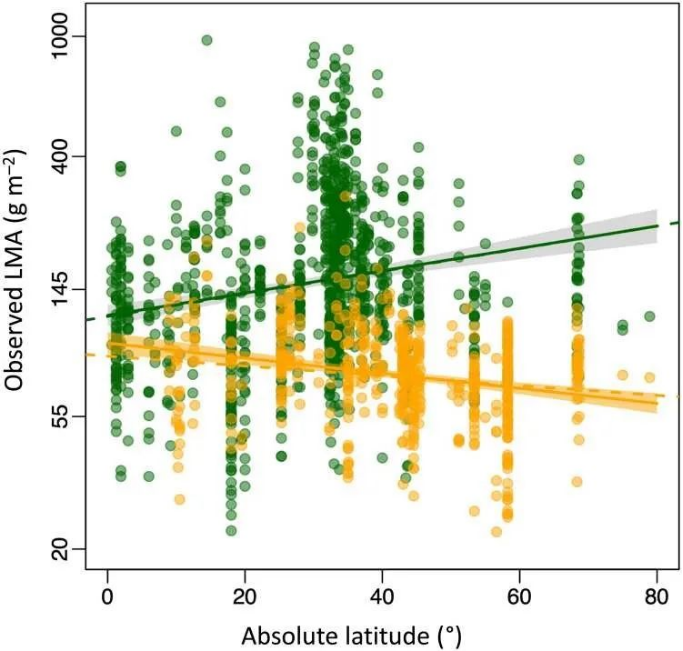Leaf economic spectrum (LES) is a character dimension ubiquitous in nature, which embodies the balance strategy of plant leaves on environmental resources and presents many interesting phenomena urgently awaiting explanation. Recently, Wang Han's Research Group of Tsinghua University has proposed a new optimal strategy theory, which successfully can predict the core balance relationship of LES and the functional diversity of mass per unit area (LMA), and explain the reasons for its differentiation in evergreen and deciduous plants. The results were published on January 19, 2023 in Science Advances, an international top journal, as an article titled “Leaf economic fundamentals explained by optimality principles”.
It is hypothesized in the study that the optimal resource balancing strategy is to maximize the average net carbon gain in the life cycle of leaves, whether for evergreen or deciduous plants. By further considering the effects of environmental factors and leaf senescence on leaf photosynthetic rate, the optimal leaf life can be predicted according to LMA and environmental conditions. Because the life span of evergreen leaves coincides with its life cycle, the life span of deciduous leaves coincides with the length of growing season, being just one year, even given the same leaf construction cost and environmental conditions, the optimal leaf life span of evergreen and deciduous plants is slightly different: the leaf life of evergreen plants is directly proportional to LMA, and inversely proportional to the photosynthetic effective radiation absorbed by leaves and the square root of the growing season length; The leaf life span of deciduous plants is proportional to the length of growing season. This theoretical prediction result has been verified by the global GlopNet trait dataset (Fig. 1).

Fig. 1. Partial residual plots for observed leaf life span (LL) against explanatory variables.
(A) LMA, leaf mass per area. (B) Iabs, site-mean leaf-absorbed PPFD. (C and D) f, fractional growing-season length. Evergreen: green. Deciduous: orange. Predicted: red. Fitted: black.
Under the framework of the optimal strategy theory, the study further introduces constraints, assuming that the leaves of evergreen plants are additionally constrained by the global joint normal distribution characteristics of LMA and leaf life span, thus directly predicting the response law of LMA of evergreen and deciduous plants to environmental factors: LMA of evergreen and deciduous plants both increases with the increase of photosynthetic effective radiation and the length of growing season, and decreases with the increase of temperature, but LMA of deciduous plants is more sensitive to environmental changes: its sensitivity to radiation is twice that of evergreen plants, and it is sensitive to temperature and growth. The direction and sensitivity of these theoretical predictions are verified by the observation data of the China Plant Traits Database, and the observation results also show that the LMA of leaves decreases significantly with the increase of the moisture index (Figure 2).

Fig. 2. Partial residual plots for observed LMA against environmental variables. Tg, mean growing-season temperature.αp, moisture index, ratio of Ratio of actual evapotranspiration to potential evapotranspiration. The meanings of the other signs are the same as Fig. 1.
Contrasting latitudinal patterns in LMA between deciduous and evergreen species are found. The difference of the two types of plants in their sensitivity to the environmental response can also be predicted quantitatively. (Fig. 3)

Fig. 3. Observed and predicted trends of LMA from tropical to polar regions.
Solid lines, regressions with 95% confidence intervals. Dashed lines: theoretical predictions.
The study reveals the well-known resource balance strategy and environmental response mechanism behind LES, and successfully predicts the changing law of LMA between and within communities, which provides a solid theoretical basis for explaining and predicting the functional diversity of plant morphological traits and its impact on the global carbon cycle.
Associate Professor Wang Han from Tsinghua University is the first and corresponding author of the article. Co-authors include Dr. Qiao Shengchao and postdoctoral Zhou Jian from our research group, as well as researchers from Imperial College London, Western Sydney University and Cornell University. The research is supported by a project of the National Natural Foundation of China.
Full-text link: https://www.science.org/doi/10.1126/sciadv.add5667
Written by Wang Han
Edited by Wang Jiayin
Reviewed by Zhang Qiang